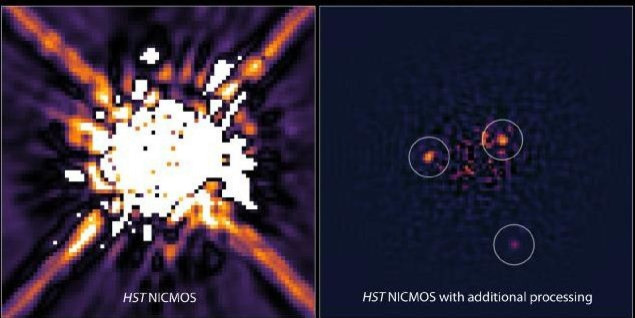Elusive Extrasolar Planets Uncovered in 13-Year-Old Hubble Data

Astronomers have found two elusive extrasolar planets that went undetected in image data from the Hubble Space Telescope for 13 years. The scientists painstakingly re-analyzed Hubble images from 1998 and stumbled upon visual evidence that the two planets went undetected then.
That year, scientists pointed Hubble at a sun-like star called HR 8799. They were hoping to find planets orbiting it, but came up empty-handed. They revisited it with 2008 images using the Gemini telescope and found four planets.
According to Discover Magazine, the planets weren't seen because the star was too bright. Additionally, software techniques 13 years ago couldn't effectively remove the star's light to show the much dimmer planets.
With technological advances since 1998, astronomers are now revisiting the old Hubble data and using new methods to clean up the images. The techniques have confirmed the existence of planets that were found in the meantime using other methods. Astronomers will also be rechecking hundreds of other stars in hopes of new discoveries.
They say uncovering the two hidden gems in the old Hubble data allows for comparison earlier planet orbital motion data with more recent observations. It is also a novel approach for planet hunting in old Hubble data.
The results of the study will be published in an upcoming issue of the Astrophysical Journal.
Astronomers know that four giant planets orbit the young, massive star HR 8799. The star is 130 light-years away.
In 2007 and 2008, Christian Marois of the National Research Council in Canada and his team, discovered the first three planets in near-infrared ground-based images taken with the W.M. Keck Observatory and the Gemini North telescope. They found a fourth and innermost planet in 2010. The fourth, innermost planet is 1.5 billion miles from the star and cannot be seen because it is on the edge of the Near Infrared Camera and Multi-Object Spectrometer coronagraphic spot that blocks the light from the central star.
It is the only multiple-exoplanet system for which astronomers have direct snapshots.
Remi Soummer, an astronomer at the Space Telescope Science Institute in Baltimore, led the new study that recovered all three of the outer planets. He compared the technique to a time machine for seeking out planets beyond our solar system. The spectrometer was used in the 1990s to seek out dusty planetary disks and brown dwarfs. The images were processed to remove any glare that remained and bring out dim details.
Astronomers say they will be able to track the orbits of planets when they locate them in several images spaced out over years. Knowing the orbits is very important in understanding the behavior of multiple-planet systems, as massive planets can perturb each other's orbits.
From the Hubble images we can determine the shape of their orbits, which brings insight into the system stability, planet masses and eccentricities, and also the inclination of the system, Soummer says.
Researchers say the three outer gas-giant planets have approximately 100-, 200-, and 400-year orbits, and astronomers will therefore, have a long wait before seeing how the planets move along their paths. When astronomers are able to tell where the planets were 10 years ago, they will calculate the orbits more precisely.
Because astronomers see where the planets were in 1998, the technique is said to work like a time machine.
The archive got us 10 years of science right now, Soummer says. Without this data we would have had to wait another decade. It's 10 years of science for free.
The outermost planet found is slow-moving and has hardly changed its position in 10 years.
But if we go to the next inner planet we see a little bit of an orbit, and the third inner planet we actually see a lot of motion, Soummer says.
Soummer plans to analyze some 400 other stars in the archive with the same technique. The stars have been selected from six surveys.
We wanted to revisit surveys taken of young, nearby stars, as these are prime targets for imaging exoplanets, said Laurent Pueyo, a NASA Sagan Fellow working with Soummer. Stars with evidence of circumstellar dust will also be good targets, as this is commonly linked with planet formation.
© Copyright IBTimes 2024. All rights reserved.






















